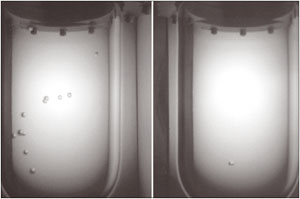The Chicagoland Observatory for Underground Particle Physics (COUPP) has tightened constraints on the spin-dependent properties of the weakly interacting massive particles (WIMPs) that are candidates for dark matter. At the same time, the Cryogenic Dark Matter Search (CDMS) has announced results that set the world’s best constraints on the spin-independent properties of dark-matter candidates.

The COUPP experiment is an intriguing new application of the bubble chamber technique, located 100 m underground in the tunnel for the Neutrinos at the Main Injector project at Fermilab. It uses a small quartz vessel at room temperature filled with 1.5 kg of superheated iodotrifluoromethane (CF3I), a refrigerant that is often used in fire extinguishers. Two effects reveal the formation of bubbles in the chamber: the sound and pressure rise caused by their growth, and the changes in their appearance monitored by two CCD cameras. Once they reach a millimetre or so in size, they trigger the system to record photographs of the chamber. The chamber then goes through a cycle of compression and decompression to bring it back to a bubble-free, superheated state.

The innovative detector offers several advantages in the search for WIMPs, the most important being that the superheated liquid can be tuned to respond only to particles with large stopping power. This means that it can be set up in such a way that muons, gamma-rays, X-rays, and other kinds of common background, deposit too little energy to form bubbles. When the detector is searching for WIMPs, the threshold for bubble nucleation is typically above 50 keV/μm.

Image credit: COUPP collaboration.
The team operated the chamber continuously from December 2005 to December 2006, with around 100 s between expansions. Although the chamber is only a prototype, the first results from COUPP, combined with the findings of other dark-matter searches, contradict the claims for the observation of WIMPs by the Dark Matter experiment (DAMA) in Italy. Previous experiments had already constrained the possibility that the DAMA observations result from dark-matter, spin-independent interactions and COUPP has now ruled out the last region of parameter space allowed for a spin-dependent explanation (Behnke et al. 2008). If the DAMA result had been due to spin-dependent WIMPs, then COUPP should have found hundreds of examples, but instead it found none above background.
The COUPP team now aims to improve the sensitivity of the experiment by increasing the amount of liquid in the detector from 1 l to 30 l, and it expects to start testing the larger chamber soon. The experiment could move to a deeper tunnel to reduce the background from cosmic radiation even further.
Meanwhile, the CDMS collaboration announced the world’s most stringent limits on how often dark-matter particles interact with ordinary matter and on how heavy they are, in particular in the theoretically favoured mass range of more than 40 times the proton mass. The CDMS experiment, situated in the Soudan Underground Laboratory, Minnesota, is now running with all of its detectors – 19 germanium detectors of 250 g each and 11 silicon detectors of 100 g. The detectors operate at 50 mK and each consists of a disc some 7.5 cm in diameter and 1 cm thick.
The new results, announced at the Dark Matter 2008 conference in Marina del Ray, California, are based on the analysis of data collected from 15 germanium detectors between October 2006 and July 2007 (Ahmed et al. 2008). The analysis resulted in no dark-matter events and excludes the parameter space for WIMPs with masses above 42 GeV/c2.





